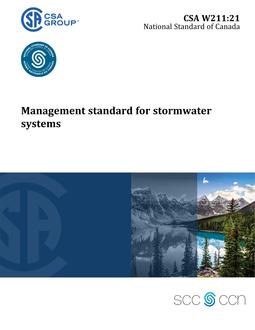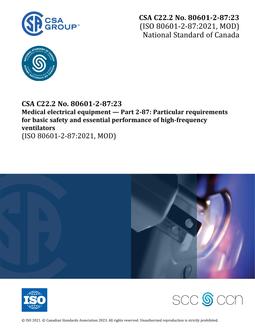
CSA W211:21
Preface
This is the first edition of CSA W211, Management standard for stormwater systems. The purpose of this Standard is to provide requirements and recommendations for management of stormwater systems. It defines a risk-based process for decision makers responsible for the operation, maintenance, and management of stormwater systems.
Users of this Standard are reminded that this Standard should not be considered a replacement for the requirements contained in any a) applicable federal/territorial or provincial statute; b) regulation, licence, or permit issued pursuant to an applicable statute; or c) contract that an owner has with a contractor. CSA Group gratefully acknowledges the generous support of Standards Council of Canada through their Standards to Support Resilience in Infrastructure Program. It was inspired by the report “Developing a Stormwater Quality Management Standard (QMS) in Light of a Changing Climate” (Engineers Canada et al., 2018). This Standard was prepared by the Subcommittee on W211, Management Standard for Stormwater Systems, under the jurisdiction of the Technical Committee on Management Standards for Stormwater Systems and the Strategic Steering Committee on Natural Resources, and has been formally approved by the Technical Committee. This Standard has been developed in compliance with Standards Council of Canada requirements for National Standards of Canada. It has been published as a National Standard of Canada by CSA Group.
Scope
1.1 General This Standard outlines minimum requirements and recommendations for the management of a stormwater system established by an operating authority. It provides a standardized guidance process to manage a stormwater system to meet regulatory requirements, reflect sound policy decision-making, and demonstrate a high standard of care to minimize legal, environmental, social, and economic risks, especially given a changing climate and hydrologic conditions. It also provides a documentation protocol to ensure all changes and decisions made in policy and procedures are well documented, and identifies steps for operating authorities to internally audit their management system. It is written with flexibility such that it could be applicable to any size of stormwater system. This Standard provides a) an outline of the key policies and procedures needed for effective management of a stormwater system; b) a framework for increasing public safety by identifying and mitigating environmental, social, legal, and economic risks to the system; and c) the ability to demonstrate enhanced environmental outcomes through the effective application and continual improvement of the stormwater management system.
1.2 Users
1.2.1 Primary users This Standard is intended for use by persons or organizations that own, manage, and/or operate a stormwater system. It also provides a framework to ensure that persons responsible for the stormwater system are provided with the information necessary to support sound decision-making. Other potential users include the following: a) Governments (federal, territorial, provincial, municipal): Governments at all levels must better understand the risks and opportunities related to stormwater planning and management. In particular, provincial/territorial governments play a key role in managing intra-jurisdictional water and land resources. Responsible authorities can use this Standard for better planning, policy making and decision-making. Municipal inspectors can be more informed to ensure conformance in the field. b) Builders/developers: Builders and developers should factor improved stormwater management and climate resiliency into infrastructure design and construction. This Standard can provide guidance around planning, design, and construction of stormwater systems. c) Technical practitioners: Engineering design, planning, and other technical practitioners within and external to government play integral roles in stormwater planning, design, and construction. This Standard can be used to better identify and manage risk, as well as integrate best practices.
1.2.2 Other stakeholders More broadly, the following other stakeholders could also use this Standard: a) trades persons/construction companies; b) home and property owners; c) property and casualty insurers; d) banks/credit unions/mortgage lenders; e) credit rating agencies; f) lawyers; g) real estate brokers/agents; h) home inspectors; i) securities commissions; j) institutional investors; and k) educational institutes.
1.3 Application
1.3.1 In scope The scope of this Standard covers the following types of systems: a) publicly owned stormwater systems; b) areas not subject to permafrost [Clause 1.3.2 h)]; c) privately owned stormwater infrastructure (e.g., commercial and industrial) that are connected to a stormwater system; and d) impacts to combined sewers as part of the operation of the stormwater system.
Note: While many aspects of this Standard could be applicable to areas subject to permafrost, these areas might have unique conditions not accounted for in this Standard.
1.3.2 Out of scope The following are out of scope for this Standard: a) sanitary sewage collection, conveyance, or treatment systems; b) the design, commissioning, or operation of combined sewers; c) the planning, design, construction, closure, or abandonment of a stormwater system, but rather to the management of these activities; d) lot-level infrastructure except where it is considered part of, or might affect, the stormwater system; e) drinking water or wastewater systems, except where these systems interact with a stormwater system; f) sea level rise or storm surge, except where these elements interact with a stormwater system; g) areas where permafrost is present (see CSA S503 for more guidance related to areas subject to permafrost); and h) individual project or infrastructure components.
1.4 Terminology In this Standard, “shall” is used to express a requirement, i.e., a provision that the user is obliged to satisfy in order to comply with the Standard; “should” is used to express a recommendation or that which is advised but not required; and “may” is used to express an option or that which is permissible within the limits of the Standard. Notes accompanying clauses do not include requirements or alternative requirements; the purpose of a note accompanying a clause is to separate from the text explanatory or informative material. Notes to tables and figures are considered part of the table or figure and may be written as requirements. Annexes are designated normative (mandatory) or informative (non-mandatory) to define their application.
Product Details
- Published:
- 12/08/2021
- ISBN(s):
- 9781488339264
- Number of Pages:
- 50
- File Size:
- 1 file , 990 KB
- Product Code(s):
- 2429623, 2429625, 2429625, 2429623
- Note:
- This product is unavailable in Belarus, Russia, Ukraine


